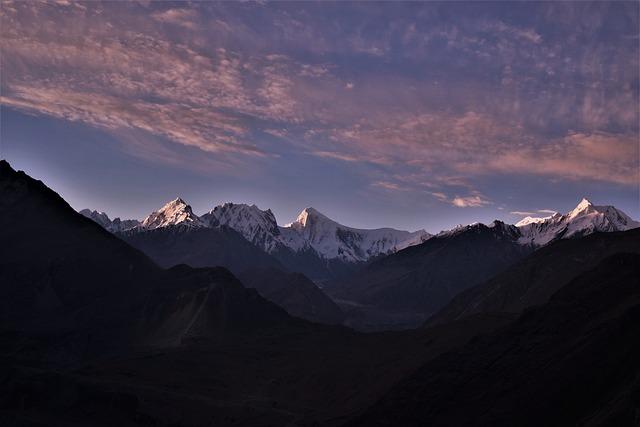Challenging Narratives: The Evolution of Journalism in Pakistan
In a world where information flows faster than the speed of light, the realm of journalism stands at a pivotal crossroads, particularly in Pakistan—a nation characterized by its rich tapestry of history, culture, and, oftentimes, discord. The evolution of journalism in this South Asian nation has been a compelling saga of resilience, transformation, and, at times, turmoil. As the traditional roles of the journalist are increasingly challenged by the rise of digital platforms and social media, the landscape of news reporting is undergoing a profound metamorphosis. This article delves into the intricate dynamics that have shaped journalism in Pakistan, exploring how reporters and media outlets navigate an ever-changing environment rife with censorship, political pressures, and the quest for truth. From the vibrant streets of Karachi to the mountainous terrains of Khyber Pakhtunkhwa, the evolution of journalism reflects not just a profession, but a critical component of society’s pulse—one that continually grapples with the stories that need to be told and the narratives that demand scrutiny. Join us as we embark on an exploration of this complex world, where the fight for unbiased reporting and the challenge of prevailing narratives create a narrative of their own.
The Shifting Sands of Truth in a Digital Era
The landscape of journalism in Pakistan has undergone profound changes, influenced by the rise of digital platforms that challenge traditional media narratives. As citizens gain access to smartphones and the internet, the flow of information has become democratized, allowing anyone to share their perspective. This shift has blurred the lines between professional journalism and citizen reporting, raising questions about credibility and authenticity. In an environment where sensational news often garners more attention, the role of established media as a fact-checker has become increasingly intricate, forcing journalists to adapt and reestablish their authority in what can sometimes feel like a chaotic digital marketplace of ideas.
Amid these challenges, some journalists and media houses have embraced innovation, leveraging technology to amplify their voices. This evolution includes exploring various multimedia formats, from podcasts to interactive articles, ensuring engagement with a broader audience. Additionally, the emergence of social media has enabled a more direct interaction between journalists and their readers, fostering an environment where transparency and accountability are paramount. The following table highlights key trends shaping journalism in Pakistan:
| Trend | Description |
|---|---|
| Citizen Journalism | Empowers individuals to report news, often through social media. |
| Multimedia Integration | Combines video, audio, and text to enhance storytelling. |
| Fact-Checking Initiatives | Non-profits and media outlets working to verify information. |
| Digital Literacy Campaigns | Efforts to educate the public on identifying credible sources. |

Navigating Press Freedom in the Face of Censorship
The landscape of journalism in Pakistan has undergone profound transformations as it grapples with the dual pressures of maintaining press freedom while countering pervasive censorship. While the advent of digital media has empowered reporters and brought new voices to the forefront, it has simultaneously opened the floodgates for governmental and institutional control. Key factors affecting this dynamic include:
- State Control: Government interventions often aim to steer the narrative, leading to self-censorship among journalists.
- Threats and Intimidation: Journalists frequently face harassment, both online and offline, which can inhibit their investigative efforts.
- Public Response: Growing public demand for transparency and accountability serves as a counterbalance to censorship, with social media platforms becoming pivotal arenas for discussion.
Moreover, as the media landscape evolves, the role of independent journalism has never been more critical. Emerging platforms harness citizen journalism’s power, enabling ordinary citizens to become storytellers and document societal issues. Despite facing numerous obstacles, many reporters continue to challenge the status quo, prioritizing the dissemination of truth and fostering public dialogue. The table below highlights the evolution of key media channels in Pakistan over recent years:
| Media Channel | Evolution Stage | Impact on Journalism |
|---|---|---|
| Traditional Print | Declining | Struggling with survival; limited reach |
| Television | Dominant | Wide audience; heavily regulated |
| Digital Platforms | Emerging | Increase in diverse voices; rapid dissemination |

Empowering Journalists: The Role of Training and Support
The evolution of journalism in Pakistan has been marked by challenges that require a committed response from the media ecosystem. To navigate the complexities of reporting in a rapidly changing environment, journalists need robust training and comprehensive support. This empowerment comes in various forms, including:
- Workshops and Seminars: Regular training sessions that cover the latest journalism trends, ethical reporting, and best practices in media.
- Mentorship Programs: Pairing experienced journalists with beginners to foster growth, provide feedback, and cultivate confidence in storytelling.
- Access to Resources: Providing journalists with essential tools, such as online databases, research materials, and technology resources, ensures well-informed reporting.
- Safe Reporting Environments: Creating supportive structures that address safety concerns, enabling journalists to report without fear.
Additionally, the establishment of collaborative networks among media professionals has proven effective in strengthening journalistic integrity. These networks facilitate the exchange of ideas and provide a platform for discussing common challenges. The impact of continued training and collective support can be illustrated through a simple overview:
| Focus Area | Impact |
|---|---|
| Ethical Reporting | Enhanced credibility among audiences |
| Digital Skills | Improved storytelling through multimedia |
| Community Engagement | Greater trust between media and the public |

Reimagining the Future: Innovations for Ethical Journalism
As the landscape of journalism evolves, the integration of technology and ethical practices is paramount to rebuilding trust with audiences. In Pakistan, journalists are increasingly leveraging innovative tools that not only enhance coverage but also prioritize the integrity of the information disseminated. Artificial Intelligence (AI) is revolutionizing fact-checking processes, enabling reporters to quickly verify claims and combat misinformation. Meanwhile, crowdsourcing has emerged as a valuable method for gathering diverse perspectives and ensuring that no voice is left unheard, particularly from marginalized communities. The use of these technologies paves the way for a more transparent and accountable media environment.
Furthermore, cultivating a strong ethical framework is essential for guiding journalism’s future in Pakistan. Initiatives that focus on training journalists in ethical reporting practices can foster a culture of responsibility and reliability. The establishment of digital platforms for ethical discussions serves as a bedrock for collaboration, allowing journalists to share experiences, challenges, and solutions. By prioritizing comprehensive media literacy programs, both journalists and the public can engage in a more meaningful dialogue about information consumption and production. This holistic approach allows journalism to not only report on crises but to actively participate in crafting narratives that reflect the true essence of society.
In Retrospect
As we navigate the intricate landscape of journalism in Pakistan, it becomes evident that the narrative is ever-evolving—a tapestry woven with threads of resistance, innovation, and resilience. The evolution of media in this dynamic country has been marked by the battle against censorship, the rise of digital platforms, and a steadfast commitment to unearthing the truth amidst turmoil. Journalists continue to challenge mainstream narratives, often at great personal risk, underscoring their vital role as the torchbearers of transparency and accountability.
Looking ahead, the future of journalism in Pakistan remains uncertain yet promising. As new generations of reporters emerge, equipped with both traditional values and modern tools, they are poised to redefine the boundaries of storytelling. The challenge lies not only in overcoming the obstacles of the past but also in harnessing the power of technology to foster a more informed, engaged society.
In this ever-changing narrative, one thing remains clear: journalism in Pakistan is not just about reporting events; it is about shaping the discourse that influences the lives of millions. As we continue to witness this evolution, may we remain vigilant supporters of press freedom, acknowledging the critical role it plays in nurturing democracy and fostering an informed populace. The story of journalism in Pakistan is far from finished; it is, in fact, just beginning to unfold.



